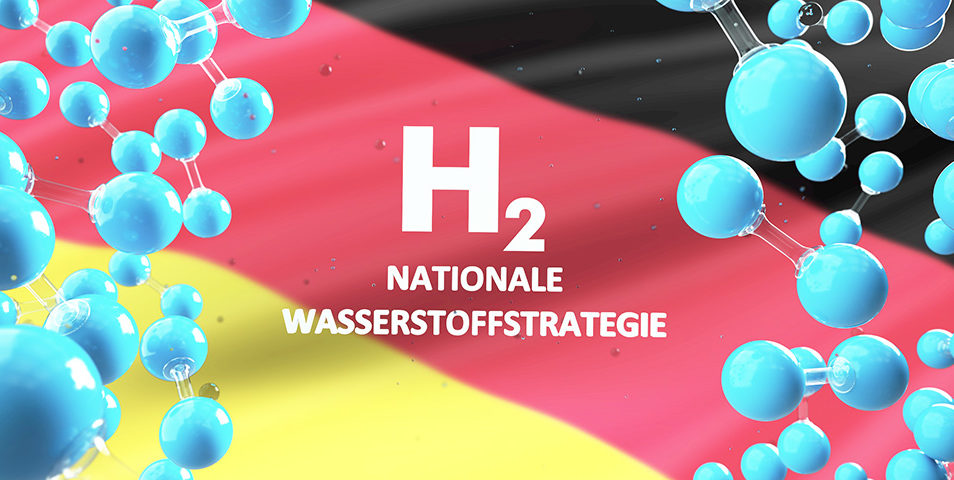Germany's new national hydrogen strategy
 © DWIH Tokyo/iStock.com/style-photography
© DWIH Tokyo/iStock.com/style-photography
September 25, 2020
[by Toru Kumagai]
Germany aims to reduce net greenhouse gas emissions, including CO2, to zero by 2050. Against that backdrop, the cabinet of Angela Merkel has introduced a hydrogen strategy that seeks to use hydrogen as a power source for manufacturing and transportation as one of the key measures to reduce CO2 emissions.
Hydrogen is a key for energy transformation
On June 10, 2020, five German ministers — including Federal Minister for Economic Affairs and Energy Peter Altmaier, Minister of Education and Research Anja Karliczek, and Minister of the Environment, Nature Conservation and Nuclear Safety Svenja Schulze — held a joint press conference in Berlin and announced that the Grand Coalition cabinet had approved a national hydrogen strategy. Minister Altmaier emphasised that hydrogen will play a key role in energy transformation.
Under this plan, Germany will target switching the energy sources for steel mills, chemical plants, lorries, shipping, airplanes from fossil fuels such as heavy oil, coal, coke and paraffin to hydrogen. Hydrogen can burn without emitting CO2, and can easily be obtained by electrolysing water. Moreover, the existing pipelines and storage tanks for natural gas can be modified and used for transporting and storing hydrogen.
The federal government of Germany has been spent 700 million euro (84 billion yen at an exchange rate of 120 yen to the euro) for basic research related to hydrogen utilisation, and it now plans to appropriate around 9 billion euros (1 trillion 8 billion yen) of budget in total to work on the construction of electrolysis facilities and the establishment of cooperation with foreign countries.
Specifically, the hydrogen production capacity by water electrolysis is to be increased to 5 gigawatts by 2030, and to a cumulative total of 10 gigawatts by 2040, which is equivalent to a capacity of almost 10 nuclear reactors.
Hydrogen also is expected to play a major role in the storage of surplus power. Currently, not all the power generated by wind power in the northern part of Germany, where there are strong winds, is able to be transferred to the southern part of the country due to the insufficient capacity of the high-voltage lines that connect the two regions, so some electricity from renewable sources becomes surplus. If such energy can be converted into hydrogen and stored in underground storage facilities in the future, then this stored hydrogen can be used later for power generation when energy is in short supply. Such technology, called Power-to-Gas (P2G), has been tested in experiments by electric and gas companies in Germany.
Producing hydrogen with renewable energy
The German government specifically focuses on green hydrogen, which is generated by using renewable energy sources including solar and wind power. It paints hydrogen into four colours according to its production methods;
| Production method | |
| Green hydrogen | Generated using electricity from renewable energy sources |
| Grey hydrogen | Generated using electricity from fossil fuels |
| Blue hydrogen | Generated using electricity from fossil fuels, but the emitted CO2 is stored to prevent it from being released into the atmosphere. |
| Turquoise hydrogen | Generated from methane using pyrolysis. Electricity from renewable energy sources is used as a heat source. |
The reason the German government places an emphasis on green hydrogen is that it can be generated without emitting CO2. German businesses and citizens are typically required to pay a renewable energy levy along with their electricity bills when they use electricity. However, the government is planning to exempt those who produce hydrogen solely from renewable energy sources from the levy: by this subsidy measure, the government aims to increase the proportion of green hydrogen.
In fact, Merkel’s government had planned to approve this hydrogen energy strategy by the end of December last year. The reason for this six-month delay in announcement was that the Ministry of Economic Affairs and the Ministry of the Environment could not agree on the treatment of grey and blue hydrogen.
The Ministry of the Environment was against the inclusion of grey hydrogen in this strategy, which is produced using electricity from natural gas and other fossil fuels.
Blue hydrogen was added to the strategy as a compromise: it is produced using electricity from fossil fuels, but the CO2 emitted during power generation is to be stored underground using technologies such as carbon capture and storage (CCS) technology, thereby preventing it from being released into the atmosphere. However, this technology has not been put to practical use in Germany, where farmers and others are opposed to CCS under the ground, due to concerns that there could be a risk of CO2 accumulating in the ground and leaking up to the surface, causing damage to crops and livestock.
Manufacturing cost is a bottleneck to commercialisation
Another issue is the capacity of hydrogen production. Germany alone will need between 90 and 110 terawatt-hours of hydrogen by 2030 to replace the fossil fuels currently used in Germany’s steel mills and elsewhere.
The German government, therefore, has acknowledged that it is impossible to produce the amount of hydrogen needed by Germany on its own, and that a large portion of it must be imported from abroad. Germany thus plans to transfer its hydrogen production technology to countries in Africa and the Middle East, and import the hydrogen produced there to help promote the economies of developing countries as well.
High cost is yet another major obstacle: according to the European Union, the cost of producing green hydrogen is between 1.7 and 3.7 times that of producing grey hydrogen. Germany’s electricity industry has been insisting that government subsidies are essential to ensure economic viability. Japan is one step ahead of Germany when it comes to research and practical applications of hydrogen energy. Recently German media have been increasingly reporting the current state of hydrogen technology in Japan. Joint research on the practical applications of hydrogen energy and exchanges between companies are expected to proceed between Japan and Germany in the near future.
R&D Activities in Germany through the eyes of a Germany-based Japanese journalist
In this nine-part series, DWIH Tokyo collaborates with Germany-based journalist Toru Kumagai to bring you the latest R&D trends in Germany.
Click here to read other articles from the series “Toru Kumagai’s report on R&D trends in Germany”.

About Toru Kumagai
Born in Tokyo in 1959, Kumagai graduated from the Department of Political Science and Economics at Waseda University in 1982 and joined Japan Broadcasting Corporation (NHK), where he gained a wealth of experience in domestic reporting and overseas assignments. After NHK, he has lived and worked as a journalist in Munich, Germany, since 1990. He has published more than 20 books on Germany and Germany-Japan relations, as well as beento numerous media outlets to report on the situation in Germany.
For more information on Japan-Germany collaboration in the field of green hydrogen, please see this page.
